Vietnamese food guide: 25 Popular street food and dishes you should try at a local restaurant
Use Vietnamese food guide to show you what types of specialty foods and dishes you will typically find on the menu around the country. I’ve created this list of my favorite foods to eat in Vietnam which always puts a premium on quality and ingredients that is fresh and sourced in season from local farmers, markets and food stores.
When you travel around Vietnam, you’ll be impressed with how simple the ingredients and dishes are and how Vietnamese food excels in making the ingredients blend and stand out in terms of all the senses at once: sweet, savory, sour, salty and spicy.
Look out for all these tasty dishes on the menu wherever you travel around Vietnam and you’re tastebuds will be happy to try all of these delicious dishes and specialty foods.
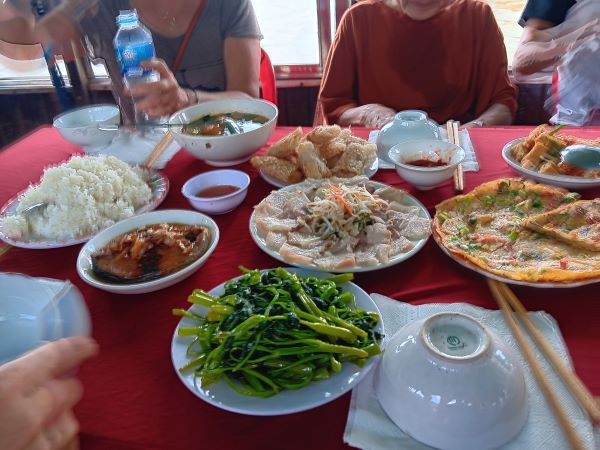
Quick Vietnamese food facts and ingredients
Vietnamese Cuisine in a Nutshell:
Vietnamese cuisine is a delightful blend of flavors, influenced by a rich history and an abundance of fresh ingredients. It’s known for its balance of sweet, salty, sour, and umami tastes. Here are some key ingredients and dishes that make Vietnamese food so enticing:
1. Rice – The Staple:
Rice is the heart and soul of Vietnamese meals. Whether it’s steamed white rice or rice noodles, it’s a fundamental part of most dishes.
2. Fresh Herbs:
Vietnamese dishes often feature a plethora of fresh herbs like cilantro, mint, Thai basil, and perilla leaves. These add a burst of flavor and freshness to every bite.
3. Fish Sauce – The Umami Elixir:
Fish sauce is a vital ingredient, used to season and provide that unique umami flavor to many Vietnamese dishes.
4. Pho – The Iconic Soup:
Pho is Vietnam’s famous noodle soup, typically made with beef (pho bo) or chicken (pho ga). It’s a bowl of comfort with a fragrant broth, rice noodles, and tender meat.
5. Spring Rolls – Fresh and Fried:
Vietnamese spring rolls come in two main types. Fresh spring rolls, called “goi cuon,” are made with rice paper and filled with shrimp, herbs, pork, and rice vermicelli. Fried spring rolls, or “cha gio,” are crispy delights stuffed with a savory mix.
6. Banh Mi – A French Influence:
The banh mi sandwich, influenced by French colonialism, combines a crusty baguette with various fillings like grilled pork, pate, cucumbers, and cilantro.
7. Bun Cha – Grilled Goodness:
Bun cha is a delicious dish featuring grilled pork patties served with vermicelli noodles and nuoc cham sauce. It’s a must-try.
8. Nuoc Cham – The Versatile Sauce:
Nuoc cham is a tangy dipping sauce made from fish sauce, lime juice, sugar, and chilies. It’s used to enhance the flavors of many dishes.
9. Coconut Milk – Creamy Touch:
Coconut milk is often used in Vietnamese curries, giving them a rich and creamy texture. It’s especially popular in southern Vietnamese cuisine.
10. Coffee – The Vietnamese Way:
Vietnam is known for its strong and sweet coffee. Try a traditional Vietnamese coffee with condensed milk for a caffeine kick with a twist.
Pros and Cons of Vietnamese Cuisine:
Pros:
- Healthy and fresh ingredients, with plenty of herbs and vegetables.
- A balance of flavors that’s both satisfying and light.
- Vegetarian and vegan-friendly options are widely available.
- A diverse range of dishes, from soups to grilled meats.
Cons:
- Some dishes may be quite spicy, so be prepared for some heat.
- The flavors can be intense, which might not suit all palates.
- Authentic ingredients can be hard to find outside Vietnam for home cooking.
Vietnamese cuisine is a treasure trove of flavors and experiences. It’s no wonder you’re eager to explore it as a food-loving traveler and content creator!
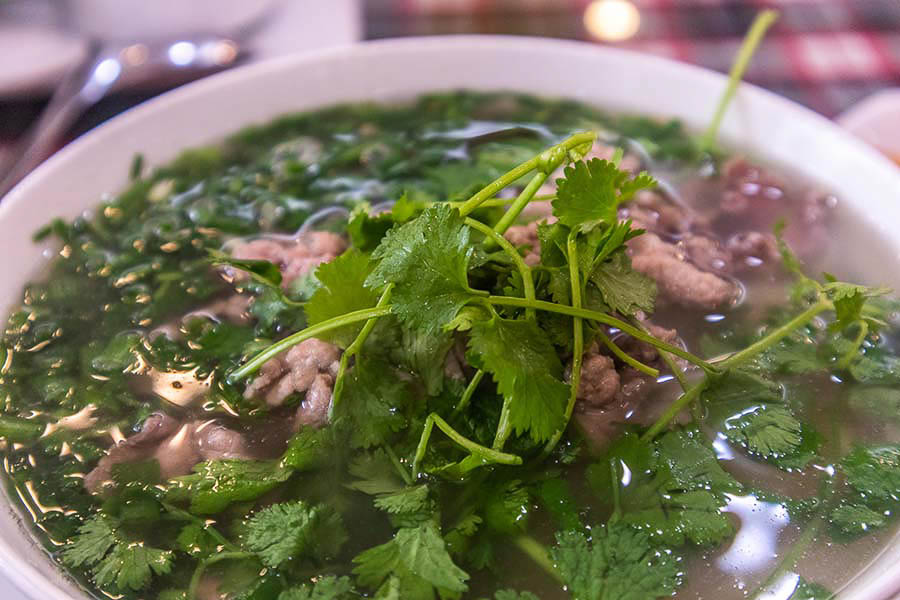
25 Delicious Vietnamese dishes on the menu

1. Bánh cuốn
What is Bánh Cuốn
Bánh Cuốn, often known as the “Vietnamese Rice Roll,” is a delightful yet simple dish in Vietnamese cuisine. It features delicate, thin sheets of rice noodle, steamed to perfection, practically melting in your mouth. These rice sheets cradle a savory mixture of minced pork, wood ear mushrooms, and shallots, seasoned with fish sauce. The dish is garnished with crispy fried shallots and bean sprouts for a delightful crunch.
The magic of Bánh Cuốn lies in its nuoc cham dipping sauce, a sweet and tangy blend of fish sauce, lime juice, sugar, and chilies, elevating the flavors. Fresh cilantro leaves and Vietnamese sausage can accompany the dish, adding additional layers of taste and texture. The rice sheets are steamed with precision to ensure a soft yet non-sticky consistency, a delicate art mastered by skilled chefs.
Bánh Cuốn offers a light and healthy dining option with a harmonious mix of textures and the zesty nuoc cham dipping sauce. However, its availability outside Vietnam may be limited, and preparing the delicate rice sheets can be a culinary challenge for home cooks. Yet, for those who appreciate a balance of flavors and textures, Bánh Cuốn is a culinary adventure worth embarking on, especially for a food-loving traveler like you.
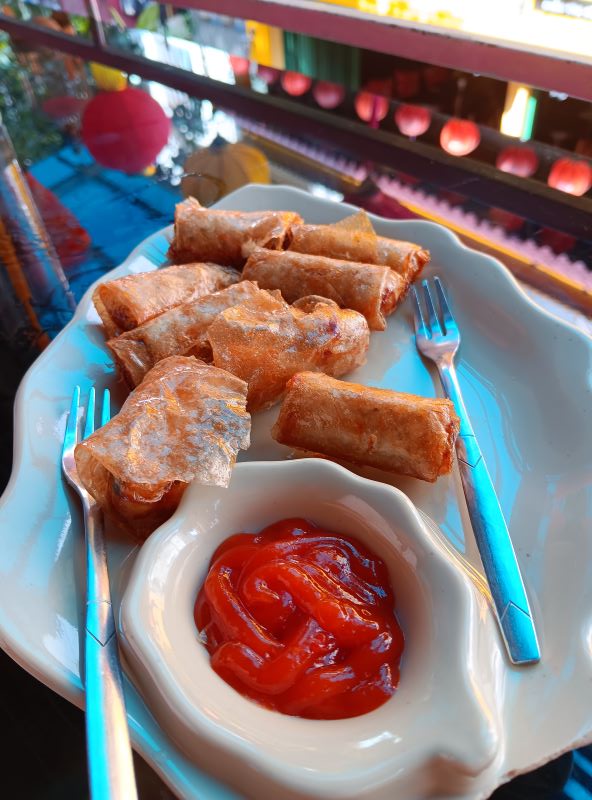
2. Gỏi cuốn (Spring Rolls)
Gỏi Cuốn, commonly known as Vietnamese Spring Rolls, is a delightful creation that is the essence of Vietnamese cuisine as an appetizer or even entree. These translucent rice paper rolls are packed with an array of fresh, vibrant ingredients, offering a taste of Vietnam’s culinary artistry.
Light and Fresh Ingredients: Gỏi Cuốn is distinguished by its use of light and fresh ingredients. Each roll typically contains a medley of rice vermicelli, succulent shrimp, thinly sliced pork, fresh herbs like cilantro and mint, and sometimes crispy fried shallots. These components come together to create a visually appealing and texturally diverse filling.
Dipping Sauce – Nuoc Cham: To elevate the flavors of Gỏi Cuốn, it is traditionally served with nuoc cham, a tangy dipping sauce made from fish sauce, lime juice, sugar, and chilies. This sauce adds a sweet and savory tang to each bite, perfectly complementing the freshness of the rolls.
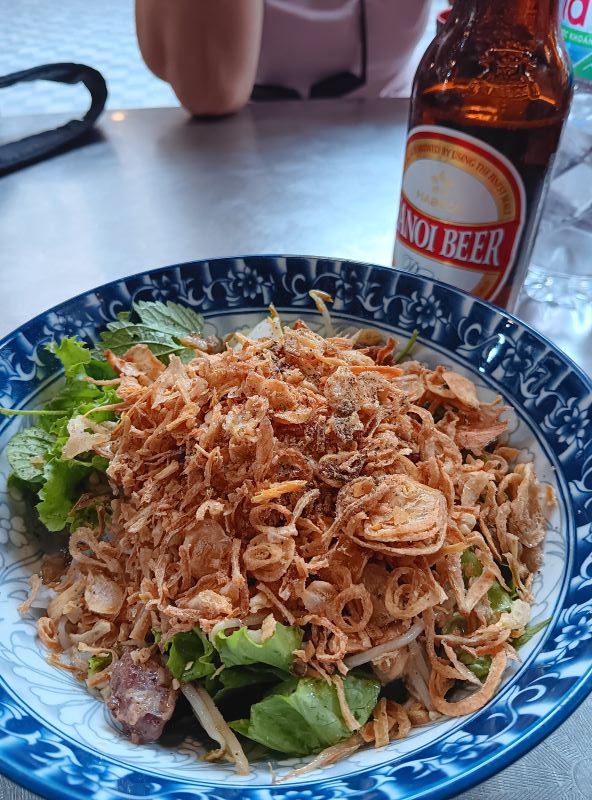
3. Delicious Bún Chả
Bún Chả is a cherished Vietnamese dish that embodies the simplicity and richness of Vietnamese cuisine. At its core, it’s a beautiful harmony of grilled pork and rice vermicelli noodles, brought to life by a sweet and savory dipping sauce.
Grilled Pork Perfection:
Bún Chả’s star is the grilled pork patties, marinated with a fragrant blend of spices and herbs. These patties are expertly charred to create a smoky, caramelized exterior that contrasts beautifully with the juicy, tender meat.
Rice Vermicelli Noodles:
Serving as the perfect base, the delicate rice vermicelli noodles absorb the dish’s flavors, creating a satisfying backdrop for the flavorful pork.
Nuoc Cham Dipping Sauce:
The nuoc cham dipping sauce, with its sweet and tangy profile crafted from fish sauce, lime juice, sugar, and chilies, unifies all elements of the dish and ensures every bite is a tantalizing burst of flavor.
Fresh Herbs and Greens:
To complete the culinary symphony, Bún Chả is accompanied by a vibrant medley of fresh herbs and greens such as mint, cilantro, and lettuce, which contribute a refreshing touch to the meal.

4. Filling and Savory Vietnamese Pho
Pho, a Vietnamese culinary icon, is a flavorful and comforting noodle soup that showcases the heart of Vietnamese cuisine. Its rich history and diverse ingredients make it a beloved dish, often enjoyed as a breakfast staple in Vietnam.
Broth – The Essence of Pho: Pho’s soul lies in its meticulously prepared broth. Traditionally, it’s made by simmering beef bones, aromatic herbs like star anise, cloves, and cinnamon, and charred onions and ginger for hours. This results in a clear, aromatic, and deeply savory base that’s nothing short of exceptional.
Noodles – A Perfect Bed: The tender, flat rice noodles used in Pho are a perfect bed for the flavorful toppings. They are cooked to perfection and serve as a blank canvas for the broth and accompanying ingredients.
Toppings – A Symphony of Flavors: Pho is traditionally served with thinly sliced beef (raw or cooked by the hot broth), but variations include chicken or even vegetarian options. The toppings can also include fresh herbs like basil, mint, and cilantro, bean sprouts, lime wedges, and chili slices. These toppings add a burst of freshness and crunch to every spoonful.
Hoisin and Sriracha – Customization: On the side, you’ll often find hoisin sauce and Sriracha, allowing diners to adjust the sweetness and spiciness of their Pho according to their taste.
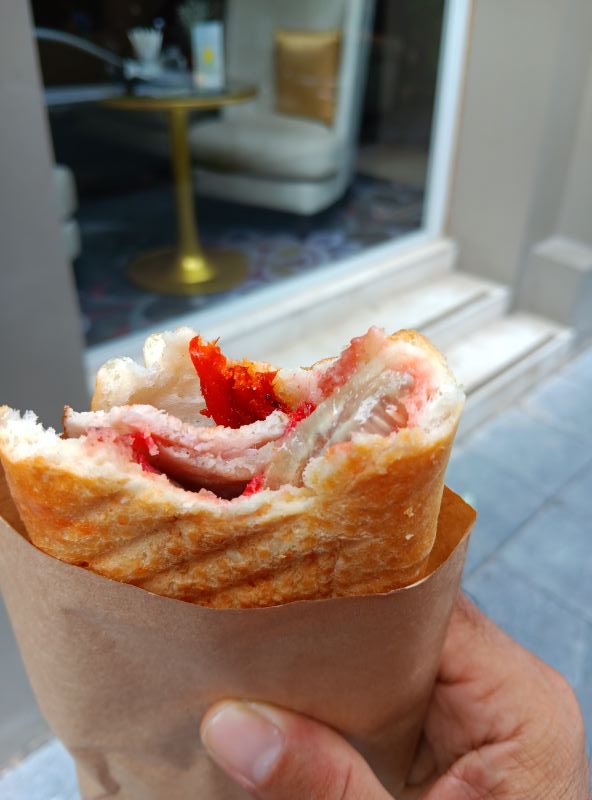
5. So good, Banh Mi sandwiches
Banh Mi to die for:
Banh Mi is a delicious Vietnamese sandwich that perfectly fuses French and Vietnamese culinary influences. At its core, it’s a delightful symphony of flavors and textures.
Crusty Baguette:
The foundation of Banh Mi is a French-style baguette, often light and crispy on the outside yet soft on the inside. This crusty canvas is where the magic begins.
Fillings Galore:
Inside the baguette, you’ll discover a treasure trove of fillings. Traditionally, Banh Mi includes a choice of protein like grilled pork, pate, or Vietnamese sausage, combined with fresh vegetables like cucumber, cilantro, and pickled carrots and daikon. These components create a harmonious blend of flavors and textures.
Condiments and Sauces:
What elevates Banh Mi to another level are the condiments and sauces. A swipe of mayonnaise or butter is often added, and then there’s the optional kick of heat from chili sauce. It’s all about personal preference, making each Banh Mi unique.
The Fusion Charm:
Banh Mi is the embodiment of fusion cuisine, combining the crispy elegance of French bread with the vibrant, savory, and spicy elements of Vietnamese flavors.
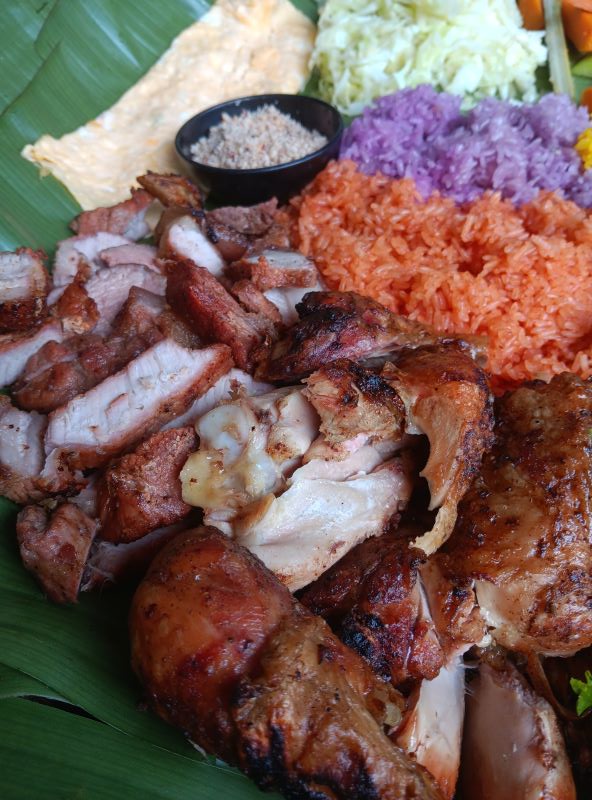
6. Ga nuong – Vietnamese grilled chicken
Gà Nướng, Vietnamese grilled chicken, is a tantalizing dish that showcases the smoky flavors and aromatic elements of Vietnamese cuisine. It’s a delightful fusion of smokiness, sweetness, and savory goodness.
Marinated Chicken:
At the heart of Gà Nướng is the chicken. It’s typically marinated in a flavorful mixture that often includes fish sauce, garlic, lemongrass, sugar, and a hint of chili for a touch of heat. This marinade infuses the chicken with a complex blend of savory and sweet notes.
On the Grill:
The marinated chicken is then expertly grilled over an open flame, allowing the flavors to intensify and the chicken to develop a smoky char. The grilling process imparts a delightful smokiness that adds depth to the dish.
Sweet Dipping Sauce:
To complement the savory and smoky chicken, Gà Nướng is often served with a sweet and tangy dipping sauce. This sauce, typically a blend of fish sauce, sugar, lime juice, and chili, provides a perfect contrast to the grilled chicken’s flavors.
Herbs and Freshness:
Gà Nướng is frequently garnished with fresh herbs like mint, cilantro, and Thai basil. These herbs provide a refreshing and aromatic element that complements the dish’s robust flavors.

7. Simple and savory Bánh xèo
Bánh Xèo, a Vietnamese is a tasty and delicious dish filled with subtle flavors and textures. This savory, crispy, and golden-hued pancake-like dish is a true delight
Bánh Xèo gets its name from the sizzling sound it makes while cooking. This rice flour crepe is infused with turmeric, lending it a captivating golden hue. The batter is crisped to perfection, creating a delicate yet satisfying crunch.
You’ll discover a tantalizing filling that typically includes a combination of different ingredients using shrimp, pork, bean sprouts, and aromatic herbs. This medley offers a harmonious blend of textures and tastes.
The Banh Xèo is typically accompanied with nuoc cham, the beloved Vietnamese dipping sauce. This sauce is made from fish sauce, lime juice, sugar, and chilies, adds a delightful burst of sweet, savory, and tangy notes to each bite.

8. Must try dish Ca Kho To (Caramelized Fish in Clay Pot)
Ca Kho To, a classic Vietnamese dish, is a tantalizing exploration of sweet and savory flavors that is so delicious on the first bite. This culinary masterpiece features succulent fish, expertly caramelized in a clay pot, creating a harmonious balance of tastes and textures.
Clay Pot Magic:
The use of a clay pot is integral to the preparation of Ca Kho To. The clay imparts a subtle earthy flavor and allows for even, slow cooking, resulting in the tenderization of the fish and the development of a rich, flavorful sauce.
Caramelized Fish:
The heart of the dish is the fish, often catfish or snakehead fish. The fish is simmered in a luscious caramel sauce that’s crafted from a mixture of fish sauce, sugar, garlic, and shallots. The sauce transforms into a sweet, sticky, and savory glaze, enveloping the fish in a delectable coating.
Flavorsome Additions:
To enhance the dish, Ca Kho To is often garnished with generous amounts of fresh scallions, cilantro, and sometimes spicy chilies, providing a burst of freshness and a subtle kick of heat.
Serving Style:
Ca Kho To is typically served with steamed rice, allowing the grains to soak up the exquisite caramel sauce, creating a harmonious and satisfying meal.
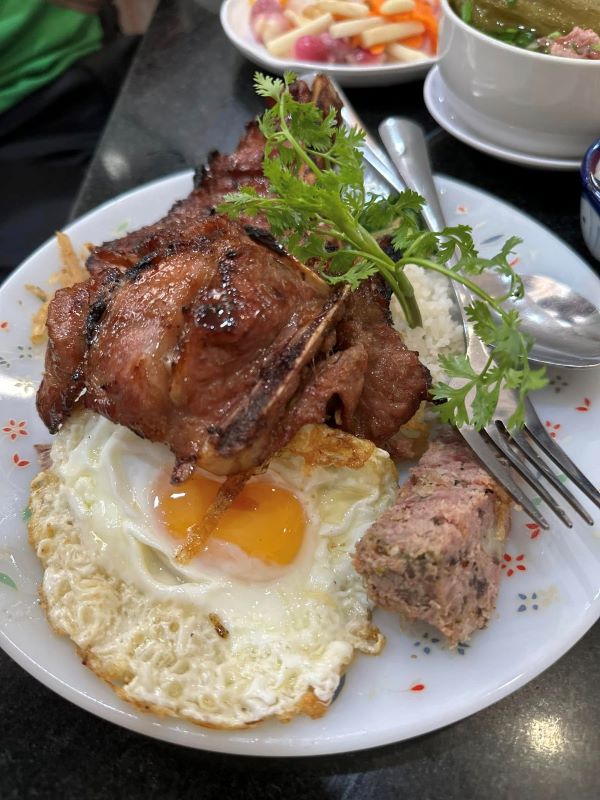
9. Cơm tấm (Broken Rice)
Cơm Tấm, known as “Broken Rice,” is a Vietnamese culinary treasure celebrated for its humble origins and delicious simplicity. This dish is a delightful journey through the textures and flavors of Vietnam.
Unique Rice Grains:
The distinctiveness of Cơm Tấm lies in its rice. Instead of whole rice grains, it features fractured rice grains, often the fragments that break during the milling process. These fragments create a unique texture, slightly coarser and more absorbent, allowing the rice to soak up the flavors of the accompanying dishes.
Protein-Packed Combinations:
Cơm Tấm is typically served with a variety of protein options. Grilled pork, shrimp, or even shredded pork skin are common choices. These proteins are marinated and expertly grilled, offering a smoky, flavorful contrast to the rice.
Fresh Herbs and Vegetables:
To balance the meal, a vibrant array of fresh herbs and vegetables, including lettuce, cucumber, and often pickled carrots and daikon, accompany Cơm Tấm. These elements provide a refreshing and crunchy contrast.
Nuoc Cham – The Essential Sauce:
What elevates Cơm Tấm is the nuoc cham dipping sauce, a blend of fish sauce, lime juice, sugar, and chilies. This sauce adds a sweet, tangy, and slightly spicy dimension to the dish.
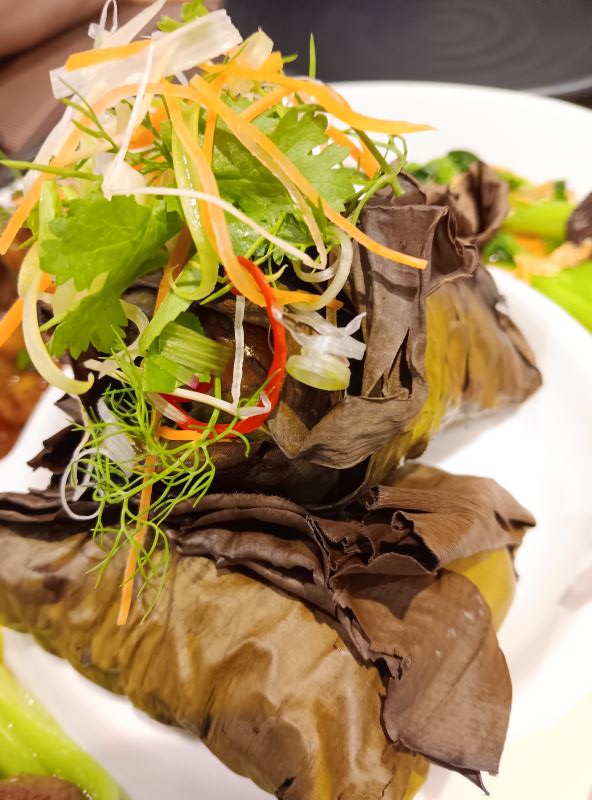
10. Refreshing Goi (Vietnamese Salads)
Exploring Goi – Vietnamese Salads:
Goi, or Vietnamese salads, offer a refreshing and healthy culinary adventure that’s filled with vibrant colors and bold flavors. These salads are a harmonious blend of fresh ingredients, herbs, and a zesty dressing that captivates the palate.
Fresh and Colorful Ingredients:
Goi salads are celebrated for their variety of ingredients. They typically feature a mix of fresh vegetables, including lettuce, cucumber, bean sprouts, and sometimes tropical fruits like green papaya or mango. These ingredients create a visually appealing and nutritious base.
Protein Options:
To elevate Goi to a satisfying meal, various protein options are added. Grilled shrimp, beef, or shredded chicken are common choices. These proteins provide a hearty contrast to the crisp vegetables.
Herbs and Aromatic Elements:
Goi wouldn’t be complete without a generous serving of aromatic herbs like mint, cilantro, and Thai basil. These herbs infuse the salad with a burst of freshness and a captivating aroma.
Dressing – Nuoc Cham:
The dressing, often a variation of nuoc cham, adds a tangy and savory dimension to the salad. It’s typically a blend of fish sauce, lime juice, sugar, and sometimes a hint of chili for a touch of heat.
Crunch and Texture:
To enhance the texture, Goi salads are frequently garnished with crunchy elements like roasted peanuts or fried shallots. This addition provides a delightful contrast to the tender ingredients.
11. Chao – tasty comfort food soup
Chao, Vietnam’s beloved rice porridge, is a comforting and nourishing dish that has a special place in the hearts of many. Often enjoyed as a soothing breakfast or a remedy for the common cold, Chao embodies the essence of warmth and simplicity.
Rice Base: At the core of Chao is rice, typically white rice or broken rice grains. These grains are simmered in an ample amount of water until they break down, creating a creamy, slightly thickened texture.
Versatile Ingredients: Chao is incredibly versatile, allowing for a variety of ingredients to be added. It can be customized with proteins like chicken, pork, or seafood, and complemented by flavorsome herbs, such as green onions, cilantro, and ginger. These additions infuse the porridge with an array of aromas and tastes.
Savory or Sweet: Chao can be served in both savory and sweet variations. While savory Chao often includes meat, seafood, and herbs, sweet Chao is made with sugar or mung beans, creating a delightful dessert.
Consistency and Comfort: The appeal of Chao lies in its creamy yet light consistency. It’s easy on the stomach and provides comfort, especially when one is feeling under the weather.
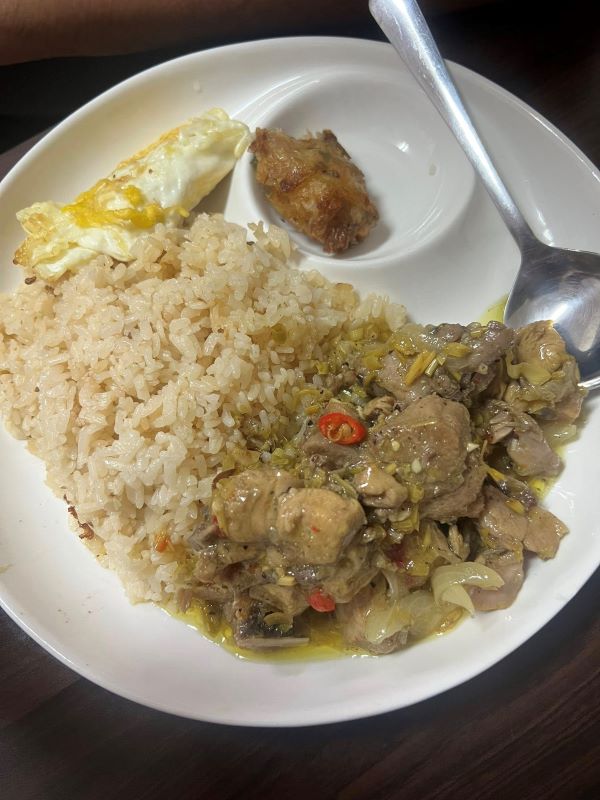
12. Gà xào sả ớt – spicy lemongrass chicken
Gà Xào Sả Ớt, or spicy lemongrass chicken, is a flavorful and zesty Vietnamese dish that sets taste buds ablaze with its bold flavors. This sizzling stir-fry exemplifies the harmony of spicy and aromatic elements.
Lemongrass Infusion:
The star of this dish is lemongrass. The lemongrass stalks are finely minced or crushed, releasing their citrusy, fragrant oils. This creates a tantalizing and zesty base for the chicken.
Spice and Heat:
Gà Xào Sả Ớt lives up to its “spicy” name with the addition of fresh chili peppers. These peppers, sliced or chopped, infuse the dish with a fiery kick, which is balanced by the bright, citrus notes of lemongrass.
Tender Chicken:
Tender pieces of chicken, often breast or thigh meat, are marinated and quickly stir-fried in a hot wok. The high heat ensures that the chicken is cooked to perfection, retaining its succulence and absorbing the aromatic lemongrass and spicy chili flavors.
Fresh Herbs and Vegetables:
To complete the dish, it’s typically garnished with a medley of fresh herbs like Thai basil, mint, and cilantro. Slices of cucumber or other fresh vegetables add a refreshing and crunchy dimension to the ensemble.
Rice – A Soothing Base:
To balance the spice, Gà Xào Sả Ớt is often served with a side of steamed rice, providing a soothing foundation to the fiery flavors.
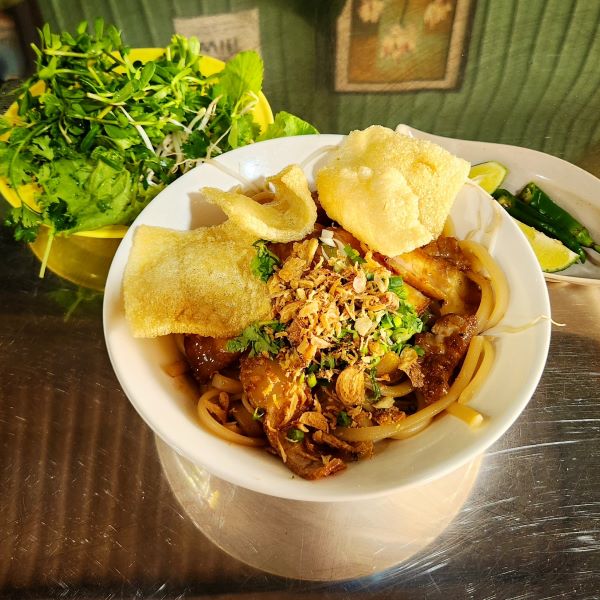
13. Cao Lầu – Vietnam’s Popular Noodle Dish
Cao Lầu is a unique and mysterious noodle dish that’s deeply connected to the town of Hoi An in Vietnam. With its distinctive ingredients and rich history, it offers a taste of local culture and culinary intrigue.
A tasty Regional Specialty:
Cao Lầu is almost exclusively found in Hoi An, making it a regional gem. Its name is derived from the local dialect, where “Cao” means “high” and “Lầu” means “floor,” possibly referencing the location where the noodles were traditionally made.
What sets Cao Lầu apart are the ingredients. The dish features thick, chewy noodles made from a secret recipe using water from an ancient well in Hoi An. These noodles are accompanied by a mixture of bean sprouts, herbs, and slices of tender pork, all bathed in a savory, umami-rich broth.
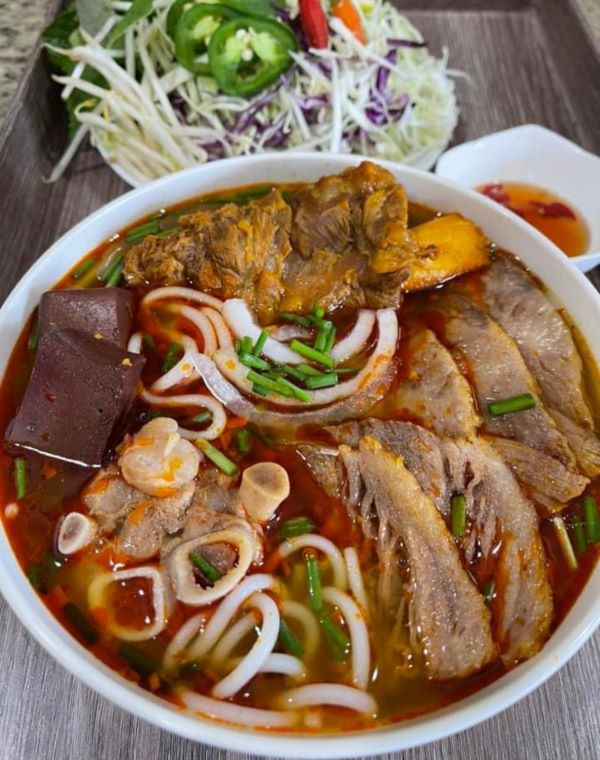
14. Bún bò Huế – spicy beef & pork Huế soup
Bún Bò Huế is a bold and flavorful soup originating from the city of Huế. It’s renowned for its complex, spicy, and aromatic profile, making it a captivating and hearty dish.
It’s about the Broth
The tastiest part of the Bún Bò Huế is its broth. It’s prepared by simmering beef bones, lemongrass, annatto seeds, and an array of fragrant spices like ginger, cloves, and star anise. The result is a rich, reddish-brown broth that’s both aromatic and spicy.
Bún Bò Huế is rich in proteins with thinly sliced beef shank, pork knuckles, and often, pig’s blood cubes are added to the soup. The combination of these proteins infuses depth and tasty bites.
About Vermicelli Noodles:
The dish is served using thick rice vermicelli noodles and provides a satisfying base absorbing the bold flavors of the broth and proteins.
It’s about the garnishes and Fresh Herbs:
Bún Bò Huế is garnished with fresh herbs including, thai basil, mint, cilantro, enhancing the aromatic quality of the dish. Sliced banana blossom, bean sprouts, and lime wedges also accompany the soup, adding a refreshing and crunchy element.
Spice and Customization:
The level of spiciness in Bún Bò Huế can be adjusted to personal preference with the addition of chili sauce or fresh chilies. This allows for customization, making the dish suit individual tastes.
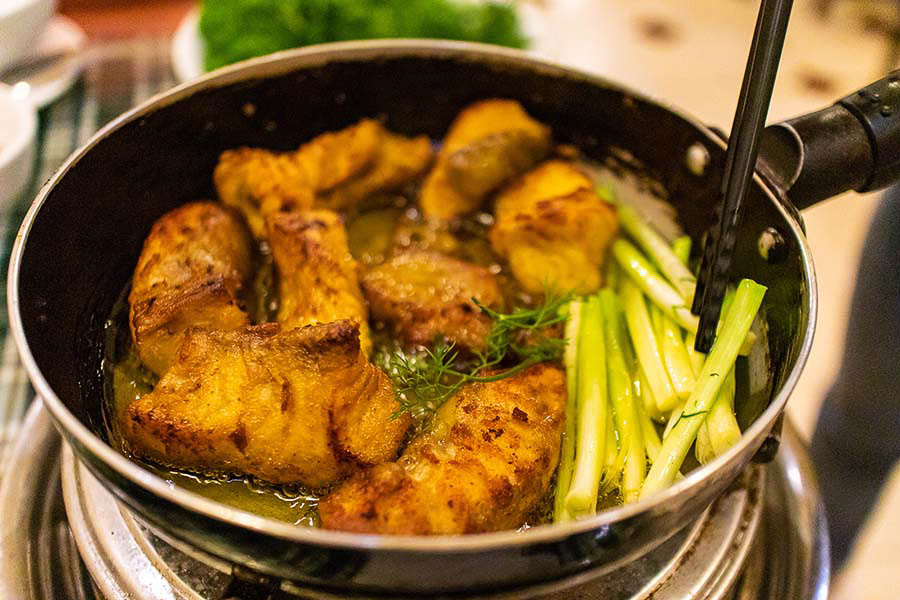
Tasty Vietnamese snacks and side dishes
If you’re into looking for some delicious street foods, snacks and easy dishes to enjoy while touring some places around the country, check out these yummy foods below:

15. Banana wrapped Banh Chung / Banh Tet
Banh Chung and Banh Tet are iconic Vietnamese dishes with a rich history deeply rooted in tradition, usually enjoyed during the Lunar New Year (Tet). These glutinous rice cakes are meticulously crafted to symbolize longevity, gratitude, and familial unity.
Glutinous Rice and Fillings: Both Banh Chung and Banh Tet are made from glutinous rice, creating a sticky and slightly chewy texture. The key difference lies in their fillings. Banh Chung typically contains a savory mix of mung beans and pork, while Banh Tet often includes ingredients like banana leaves, green beans, and pork. The fillings are carefully layered, creating a beautiful mosaic within the rice.
Banana Leaves and Steaming: To form these cakes, the rice and fillings are carefully wrapped in banana leaves, creating a rectangular shape for Banh Chung and a cylindrical shape for Banh Tet. The use of banana leaves adds a subtle, earthy aroma to the dish. These parcels are then steamed for hours until they become a harmonious blend of flavors.
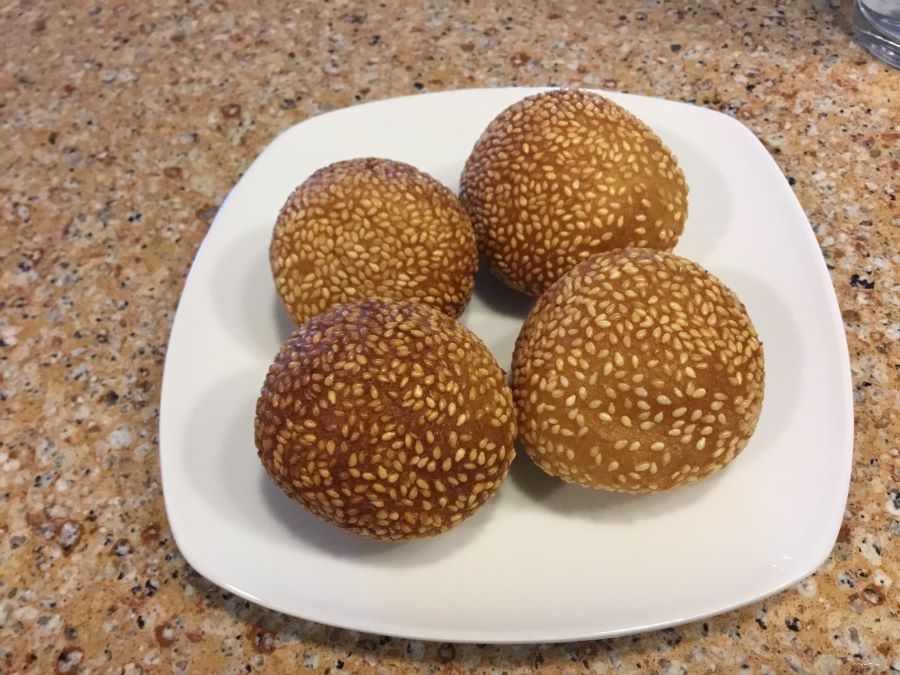
16. Banh Cam / Banh Ran
Banh Cam and Banh Ran are delightful Vietnamese pastries that offer a tempting combination of crispy exteriors and sweet, gooey fillings. These treats are popular street foods and are particularly enjoyed during special occasions and celebrations.
Crispy Outer Shell: Both Banh Cam and Banh Ran are known for their signature crispy outer shells. These shells are made from glutinous rice flour and are deep-fried to a golden perfection. The result is a satisfying contrast between the crunchy crust and the soft, sweet interior.
Sweet Fillings: The heart of these pastries lies in their sweet fillings. Banh Cam is typically filled with sweet mung bean paste, while Banh Ran often contains a mixture of sweet mung bean paste and desiccated coconut. These fillings provide a rich, velvety sweetness that beautifully complements the crispy shell.
Sugar Coating: To enhance the indulgence, these pastries are often rolled in a coating of white sesame seeds, creating an extra layer of texture and a subtle nutty flavor. This coating adds to the overall sensory experience.
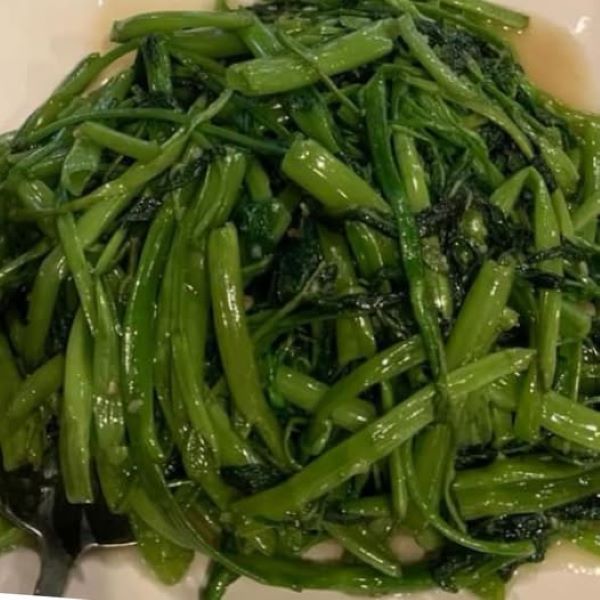
17. Rau muong – water spinach
Rau Muong, often referred to as “water spinach” or “morning glory,” is a popular and versatile leafy green vegetable that holds a special place in Vietnamese cuisine. Known for its fresh, crisp, and slightly peppery taste, it’s a staple in numerous dishes, contributing both flavor and nutrition.
Leafy and Vibrant: Rau Muong is recognizable by its long, slender stems and vibrant green leaves. Its mild, slightly earthy flavor makes it a versatile ingredient in various Vietnamese dishes.
Sautéed Goodness: One of the most common ways to prepare Rau Muong is to stir-fry it with garlic, creating a quick and flavorful side dish. The high heat gives it a pleasant wilted texture, retaining its vibrant color and fresh taste.
Soup and Noodle Dishes: Rau Muong often finds its way into Vietnamese soups and noodle dishes, such as Pho and Bun. It adds a refreshing and crunchy element, enhancing the overall balance of flavors in these dishes.
18. Hot Vit Lon – Exploring Fetal Duck Eggs
Hot Vit Lon, also known as “fetal duck eggs” or “balut,” is a unique and polarizing Vietnamese delicacy that offers a distinctive culinary adventure. These eggs are consumed in various forms across Southeast Asia, but in Vietnam, they hold a special place.
Unusual Preparation:
What sets Hot Vit Lon apart is the stage of development of the duck embryo within the egg. The eggs are typically fertilized and allowed to develop for about 17 to 21 days. At this point, you have a partially developed duck embryo within the eggshell.
Texture and Flavors:
The contents of Hot Vit Lon can be divided into three parts. The yolk, which has a creamy texture and rich flavor, is the most prized. The white, although tougher in texture, is also enjoyed. The duck embryo itself, often recognizable with its features like beak and feathers, is an acquired taste for some.
Cooking and Presentation:
Hot Vit Lon is typically boiled and served hot. The eggs are usually presented with a pinch of salt and fresh herbs like basil or Vietnamese mint, and sometimes accompanied by a zesty dipping sauce made from salt, lime juice, and chili.

19. Patê sô – meat-filled puff pastries
Patê Sô, a filling and tasty Vietnamese snack, is a delectable combination of flaky puff pastry and a savory meat filling. These bite-sized pastries offer a perfect blend of textures and flavors.
Flaky Puff Pastry:
At the heart of Patê Sô is the puff pastry. This pastry is expertly crafted to be light, airy, and delightfully flaky. The layers of the pastry add a pleasing crunch and a melt-in-your-mouth quality.
Savory Meat Filling:
The filling of Patê Sô typically consists of seasoned ground meat, often a mixture of pork and chicken. This filling is generously spiced with ingredients like onions, garlic, and fish sauce, creating a savory and flavorful core.
Perfectly Bite-Sized:
Patê Sô is usually crafted as small, hand-held pastries. Their size makes them a convenient and satisfying snack, whether enjoyed on the go or as part of a larger meal.
Variety and Customization:
While the classic Patê Sô is a savory meat filling, variations can include ingredients like quail eggs or even a sweet custard. The adaptability of the puff pastry allows for creative twists on this beloved snack.
Vietnamese desserts and pastries
20. Chè or dessert soup
Chè is a uniquef Vietnamese sweet soup and dessert combined that showcase the country’s love for combining unique flavors and textures in a single, satisfying bowl. It’s a diverse world of sweet concoctions.
Endless Varieties:
What makes Chè fascinating is its diversity. There are countless variations, each offering a delightful blend of ingredients, colors, and tastes. These can include elements like mung beans, coconut milk, glutinous rice, fruit, jellies, and even sweet corn. The combinations are seemingly endless.
Hot and Cold Delights:
Chè is equally enjoyable hot or cold. Hot Chè, often made with beans, rice, and root vegetables, provides a comforting experience during cooler weather. Cold Chè, featuring fruit, jellies, and coconut milk, is a refreshing choice on a warm day.
Dessert or Snack:
Chè serves as both dessert and snack in Vietnamese culture. It’s commonly enjoyed at the end of a meal, but street vendors also offer it as a convenient, on-the-go treat.
Customization and Creativity:
The versatile nature of Chè allows for endless customization. You can tailor it to your preferences by choosing your favorite ingredients and toppings, making each bowl a personalized delight.
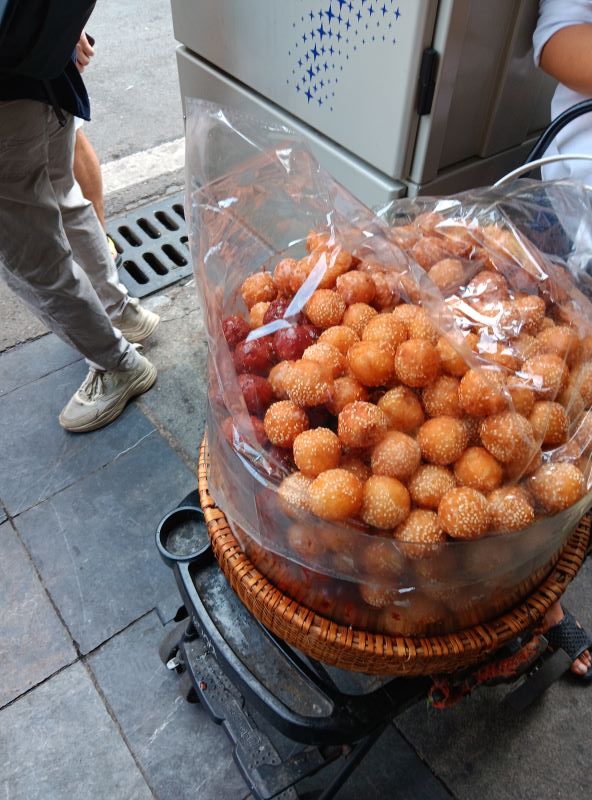
21. Bánh cam – fried sesame balls
Bánh Cam, often referred to as fried sesame balls, is a beloved Vietnamese dessert that combines a delightful crunch with sweet, gooey fillings. These golden-hued treats are a delectable adventure in textures and flavors.
Crispy Exterior:
The hallmark of Bánh Cam is its crispy outer shell. These shells are made from glutinous rice flour, which is deep-fried to perfection. The result is a satisfying, golden-brown crust that provides a delightful crunch.
Sweet Fillings:
What lies within these crispy shells is a sweet and gooey filling. Traditional Bánh Cam is often filled with sweet mung bean paste, creating a velvety, saccharine core. This filling is a perfect complement to the crispy exterior.
Sesame Coating:
To add an extra layer of texture and a subtle nutty flavor, Bánh Cam is typically rolled in white sesame seeds. These seeds adhere to the exterior, creating a delicate, slightly crunchy layer that enhances the overall experience.
Perfectly Bite-Sized:
Bánh Cam is typically small in size, making it an ideal bite-sized treat that’s perfect for snacking or satisfying your sweet tooth.
22. Avocado Ice Cream – A Cool Vietnamese Delight:
Avocado ice cream in Vietnam is a delightful dessert that’s both refreshing and creamy. It offers a unique twist on traditional ice cream, showcasing the creamy richness of ripe avocados and a hint of sweetness.
Creamy Avocado Base:
The key to this ice cream is the use of ripe avocados. These avocados are mashed to create a smooth, creamy base that gives the ice cream a lush and velvety texture. The natural fats in avocados lend a satisfying richness to the dessert.
Sweetness and Flavor:
While avocados bring a mild, buttery flavor to the ice cream, a touch of sweetness is added to enhance the taste. This can be achieved with condensed milk, which not only sweetens the dessert but also contributes to its creamy consistency.
Cool and Refreshing:
Avocado ice cream is particularly popular in Vietnam’s tropical climate. Its cool and refreshing nature provides a pleasant escape from the heat, making it a favored treat among locals and visitors.
Variations and Toppings:
Depending on where you try it, you might find variations of avocado ice cream. Some vendors add toppings like crushed peanuts, coconut flakes, or a drizzle of chocolate sauce to enhance the flavor and texture.
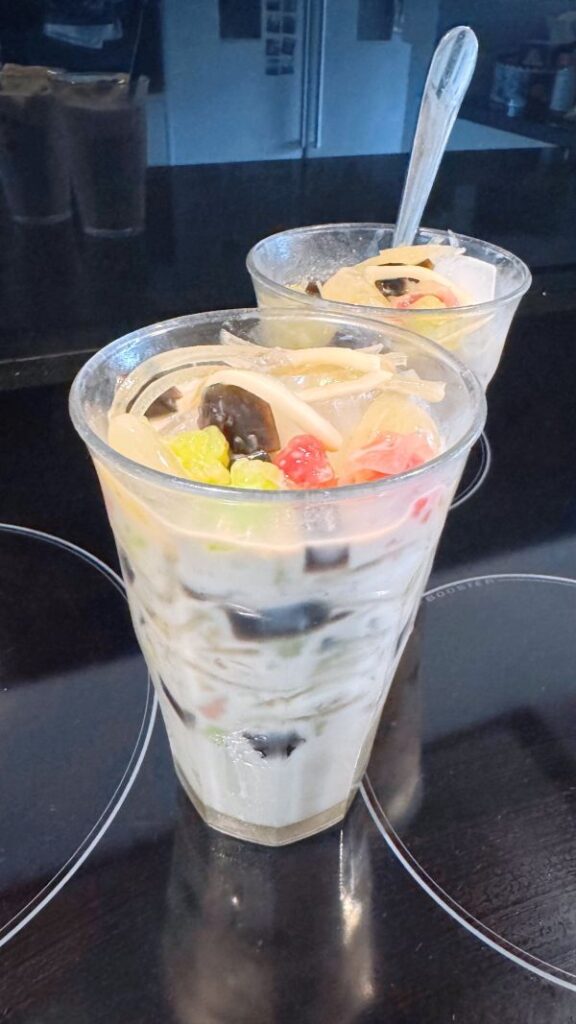
23. Pastry and other desserts
You’ll find a lot of popular street food desserts or more elaborate sweet concoctions to try when you visit around the country. Here are some of the popular favorites to eat from the North to the South.
I. Northern Vietnam
A. Chè (Sweet Soups)
- Chè đỗ đen – Black bean sweet soup, served hot or cold.
- Chè bà cốt – Sticky rice porridge with ginger and molasses.
- Chè kho – Thick mung bean pudding, often made for Tet (Lunar New Year).
B. Cakes and Pastries
- Bánh cốm – Green rice flake cake filled with mung bean paste (Hanoi specialty).
- Bánh chín tầng mây – Steamed layered rice cake in colorful layers.
- Bánh tro (bánh gio) – Glutinous rice dumplings boiled in lye water, often eaten during summer festivals.
II. Central Vietnam
A. Hue-style Delicacies
- Chè Huế – A wide variety of colorful sweet soups, including:
- Chè hạt sen (lotus seed sweet soup)
- Chè bắp (sweet corn pudding)
- Chè đậu ván (white bean sweet soup)
- Bánh nậm ngọt – Soft rice flour cake with coconut filling, steamed in banana leaves.
B. Coconut-based Sweets
- Kẹo mè xửng – Hue’s sesame and peanut chewy candy.
- Bánh lọc ngọt – Tapioca dumplings filled with mung beans and coconut.
III. Southern Vietnam
A. Refreshing and Colorful Desserts
- Chè ba màu – “Three-color dessert” with mung bean paste, red beans, pandan jelly, and coconut milk.
- Chè thái – Fruit cocktail with jellies and lychee or jackfruit in sweet coconut milk.
- Chè trôi nước – Glutinous rice balls filled with mung bean paste in sweet ginger syrup.
B. Street and Tropical Treats
- Bánh flan (caramen) – Vietnamese-style crème caramel, often served with coffee or ice.
- Kem chuối – Frozen banana and coconut milk popsicle with roasted peanuts.
- Xôi xoài / xôi mít – Sticky rice with mango or jackfruit, topped with coconut cream.
IV. Throughout Vietnam (Nationwide Favorites)
- Sinh tố – Fresh fruit smoothies (e.g., avocado, soursop, mango).
- Chè đậu xanh – Mung bean sweet soup, available hot or iced.
- Bánh da lợn – Steamed layered cake made with pandan and mung beans.
- Rau câu dừa – Coconut jelly dessert served in coconut shells.
24. Cà phê – Vietnamese coffee
Cà Phê, or Vietnamese coffee, is a sensory and a strong but sweet coffee drink that is an iconic part of Vietnam’s culture and cuisine. It’s a unique coffee experience, celebrated for its intense flavor, brewing methods, and charming presentation.
Robust Coffee Beans:
Vietnamese coffee is primarily made from robusta beans, which are known for their strong, bold flavor and higher caffeine content. These beans are often roasted to a dark level, contributing to the coffee’s distinctive taste.
Drip Brewing – Phin Filter:
What sets Vietnamese coffee apart is its method of brewing. A phin filter, a small drip filter, is commonly used. It allows the hot water to slowly drip through the coffee grounds, extracting the flavors and aroma with precision. This method results in a rich and concentrated brew.
Sweetened Condensed Milk:
One of the signature elements of Cà Phê is the use of sweetened condensed milk. This adds a creamy sweetness to the coffee, creating a perfect balance with the intense coffee flavor.
Iced or Hot:
Cà Phê can be enjoyed hot or iced. Iced Cà Phê is particularly popular in the sweltering Vietnamese climate. It’s made by brewing the coffee directly over a glass filled with ice and a generous pour of sweetened condensed milk.
Egg Coffee:
Vietnam is also famous for its unique egg coffee, where egg yolks are whipped with condensed milk to create a frothy, creamy topping for the coffee. It’s a delightful variation that’s often served hot.

25. Sugar cane drink
Drinking fresh sugar cane juice in Vietnam is a refreshing experience that perfectly captures the country’s vibrant street culture. Often sold from small roadside stalls or mobile carts, the juice is pressed right before your eyes as long stalks of sugar cane are fed through a squeaky metal press, releasing a pale green, frothy liquid. Served over ice and sometimes mixed with a squeeze of calamansi or a hint of kumquat, the drink is sweet, fragrant, and deeply cooling—an ideal antidote to the tropical heat. Locals and travelers alike pause for a glass while scooters buzz past, savoring the simple pleasure of this naturally sweet, energizing drink.
Check out these other posts to visiting Vietnam
Imperial Hue in Central Vietnam
Final thoughts on tasting 25 Vietnamese food to eat
Tasting Vietnamese food is like embarking on a captivating journey through a world of vibrant flavors, enticing aromas, and delightful textures. From the bustling streets of Hanoi to the bustling markets of Ho Chi Minh City, Vietnamese cuisine is an ever-evolving tapestry of culinary treasures waiting to be explored.
The beauty of Vietnamese food lies in its diversity. It’s a tapestry of dishes, each woven with its unique ingredients and preparation methods. Whether it’s the rich and hearty Pho, the fiery Bun Bo Hue, or the simplicity of a Banh Mi sandwich, there’s something to suit every palate.
Vietnamese cuisine beautifully balances bold and subtle flavors, offering a spectrum that ranges from the earthy depth of fish sauce to the zesty freshness of lime and herbs. It’s a cuisine that harmoniously blends sweet, sour, salty, and umami tastes, creating a true feast for the senses.
The act of sampling Vietnamese food isn’t merely about satisfying your taste buds; it’s a way to connect with the culture and people of this wonderful country. It’s about sitting down at a street-side stall, savoring a bowl of Bun Rieu, and chatting with the locals to learn about their way of life.


